| Origami Heaven A paperfolding
paradise
The website of
writer and paperfolding designer David Mitchell
x
|
| |
| Designs from the
Paul Jackson Cube |
|
| |
| This page contains brief details of designs
derived from the Paul Jackson Cube. If you are aware of
any other such designs please let me know. The Paul Jackson Cube, is a plain sided cube
made from six very simple modules. The modules are provided
with tabs but there are no pockets, the tabs of one
module simply slotting neatly in between the tabs on two
others and inside the cube as a whole, a method which
proves sufficent to hold the cube together surprisingly
well.
On its own it is quite possibly the best
design in the whole modular origami repertoire but it
also possesses three key qualities which make it an ideal
design to construct variations from:
1. The faces of the
cube are plain and each is made from a single module.
This makes it easy to achieve a clean result when
distorting the form.
2. It is easy to
take the modules apart and put them back together in
different arrangements without damaging them.
3.When used as a
macromodule the Paul Jackson Cube is compatible with the
Robert Neale Octahedron and my Tricorne when folded from
the same size squares.
The Paul Jackson
Cube is an even distribution design, the surface of the
finished cube being four layers thick at every point.
|
| |
| |
| |
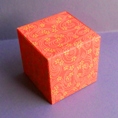 |
|
Name: The Paul
Jackson Cube Modules / Paper
shape / Folding geometry: 6 modules from squares
using standard folding geometry.
Designer /
Date: Paul Jackson, early 1970's.
Diagrams:
On-line diagrams can be found on the Modular Designs page of this site..
|
|
| |
| Patterned
Variations |
| |
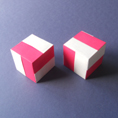 |
|
Name: Iso Cubes -
variations of the Paul Jackson Cube that can be
assembled from the same set of modules. Modules / Paper
shape / Folding geometry: 6 modules from squares
using standard folding geometry.
Designer /
Date: David Mitchell, 2001.
Diagrams:
In Building with Butterflies (2nd Edition) -
Water Trade - ISBN 978-9534774-7-0.
|
|
| |
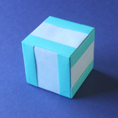 |
|
Name: The
Centre Stripe Cube - a
decorative variation of the Paul Jackson Cube. Modules / Paper
shape / Folding geometry: 6 modules from squares
using standard folding geometry.
Designer /
Date: David Mitchell, 1989.
Diagrams:
Not yet available.
|
|
| |
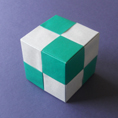 |
|
Name: The Chequerboard Cube -
a decorative variation of the Paul
Jackson Cube. Modules / Paper shape / Folding
geometry: 6 modules from squares using standard
folding geometry.
Designer /
Date: David Mitchell, 1989.
Diagrams:
In Building with Butterflies (2nd Edition) -
Water Trade - ISBN 978-9534774-7-0.
|
|
| |
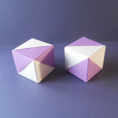 |
|
Name: Yin Yang Cubes
- variations of the Paul Jackson Cube that can
both be assembled from the same set of modules. Modules / Paper
shape / Folding geometry: 6 modules from squares
using standard folding geometry.
Designer /
Date: David Mitchell, 2001.
Diagrams:
In Building with Butterflies (2nd Edition) -
Water Trade - ISBN 978-9534774-7-0.
|
|
| |
 |
|
Name: Inside Out Yin Yang
Cube - variation of the Paul Jackson
Cube that makes use of an internal slit cut in
the module through which one half of the module
is turned inside out. Modules / Paper
shape / Folding geometry: 6 modules from squares
using standard folding geometry.
Designer /
Date: David Mitchell, 2001.
Diagrams:
Not yet available
|
|
| |
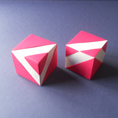 |
|
Name: Single Diagonal Stripe
Cubes - variations of the Paul Jackson
Cube that can be assembled from the same set of
modules. Modules / Paper shape / Folding
geometry: 6 modules from squares using standard
folding geometry.
Designer /
Date: David Mitchell, 2001.
Diagrams:
In Building with Butterflies (2nd Edition) -
Water Trade - ISBN 978-9534774-7-0.
|
|
| |
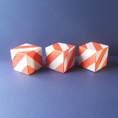 |
|
Name: Double Diagonal Stripe
Cubes - variations of the Paul Jackson
Cube that can be assembled from the same set of
compound modules. Modules / Paper shape / Folding
geometry: 6 compound modules, each from two
squares using standard folding geometry.
Designer /
Date: David Mitchell, 2001.
Diagrams:
In Building with Butterflies (2nd Edition) -
Water Trade - ISBN 978-9534774-7-0.
|
|
| |
| Surface
Distortions |
| |
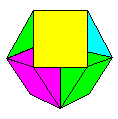 |
|
Name: The Paul
Jackson Cuboctahedron - produced by
inverting all the corners of the Paul Jackson
Cube to the mid-point of each edge. Modules / Paper
shape / Folding geometry: 6 modules from squares
using standard folding geometry.
Designer /
Date: Paul Jackson, shortly after discovering his
eponymous cube, in the early 1970s.
Diagrams:
Not yet available.
|
|
| |
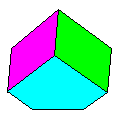 |
|
Name: The Columbus
Cube - inverting just one corner of the
Paul Jackson Cube produces a cube that will stand
on one corner on a flat surface and act as a
macromodule. Modules / Paper shape / Folding
geometry: 6 modules from squares using standard
folding geometry.
Designer /
Date: David Mitchell, 1989.
Diagrams:
In Building with Butterflies - David Mitchell -
Water Trade - ISBN 978-0-9534774-7-0.
|
|
| |
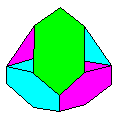 |
|
Name: The Tetracube
- which lie at the corner of one of the
tetrahedra that could be inscribed within it.
Unlike the Columbus Cube the Tetracube is a
regular modular design. The Tetracube will also
act as a macromodule. Modules / Paper
shape / Folding geometry: 6 modules from squares
using standard folding geometry.
Designer /
Date: David Mitchell, 1990.
Diagrams:
In Building with Butterflies - David Mitchell -
Water Trade - ISBN 978-0-9534774-7-0.
|
|
| |
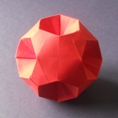 |
|
Name: Paper
ball - a robust ball made by distorting
all six corners of the Paul Jackson Cube. I made
the ball in the picture in 1989 and have played
keep it up tennis and catch with it on several
occasions since. As you can see, it has survived
quite well. Modules / Paper shape / Folding
geometry: 6 modules from squares using standard
folding geometry.
Designer /
Date: David Mitchell, 1989.
Diagrams:
Not yet available.
|
|
| |
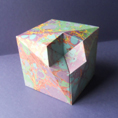 |
|
Name: Metamorphosis
- arrived at by applying the
metamorphosis 1 distortion to one complete corner
of the Paul Jackson Cube. Modules / Paper
shape / Folding geometry: 6 modules from squares
using standard folding geometry.
Designer /
Date: David Mitchell, 1990. In its final clean
form the design is my own but it owes much to the
earlier work of Iris Walker, Ricky Wong and Wayne
Brown.
Diagrams:
In Building with Butterflies - David Mitchell -
Water Trade - ISBN 978-0-9534774-7-0.
|
|
| |
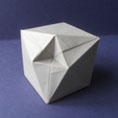 |
|
Name: Metamorphosis
2 - arrived at by applying the
metamorphosis 2 distortion to one complete corner
of the Paul Jackson Cube. Modules / Paper
shape / Folding geometry: 6 modules from squares
using standard folding geometry.
Designer /
Date: David Mitchell, 1990.
Diagrams:
In Building with Butterflies - David Mitchell -
Water Trade - ISBN 978-0-9534774-7-0.
|
|
| |
 |
|
Name: The Icarus Cube Modules / Paper
shape / Folding geometry: 6 modules from squares
using standard folding geometry.
Designer /
Date: David Mitchell, 1998.
Diagrams:
In Building with Butterflies - David Mitchell -
Water Trade - ISBN 978-0-9534774-7-0.
|
|
| |
| Cuboids |
| |
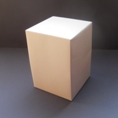 |
|
Name: The Paul
Jackson Silver Cuboid is the result of
folding four of the modules of the Paul Jackson
Cube from silver rectangles instead of from
squares. Similar cuboids can be obtained by
starting with any other rectangle, although the
design becomes less stable as the height of the
cuboid increases. Modules / Paper shape / Folding
geometry: 2 modules from squares and 2 sets of 2
modules from silver rectangles, all folded using
standard folding geometry.
Designer /
Date: David Mitchell, 2015.
Diagrams:
Not yet available.
|
|
| |
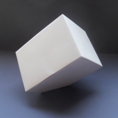 |
|
Name: The Columbus
Silver Cuboid is a version of the Paul
Jackson Silver Cuboid in which one corner has
been inverted to the mid-point of two short edges
and symmetrically to the adjacent long edge. Like
the Columbus Cube it will function as a
macromodule. Modules / Paper shape / Folding
geometry: 2 modules from squares and 2 sets of 2
modules from silver rectangles, all folded using
standard folding geometry.
Designer /
Date: David Mitchell, 2015.
Diagrams:
Not yet available.
|
|
| |
| Macromodular
Designs |
| |
 |
|
Name: The Columbus
Tower, also known as the Columbus
Cubes, is made by the
simple expedient of stacking Columbus Cubes one
on top of the other. Columbus Towers can be
combined to form walls and forests. Modules / Paper
shape / Folding geometry: Each Columbus Cube is
made from 6 modules from squares using standard
folding geometry.
Designer /
Date: David Mitchell, 1989.
Diagrams:
In Building with Butterflies - David Mitchell -
Water Trade - ISBN
|
|
| |
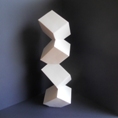 |
|
Name: Columbus
Silver Cuboids can be stacked to create a Columbus
Silver Cuboid Tower, and combined to
form walls and forests in the same way as the
Columbus Cube. Columbus Cuboids folded from
longer rectangles may not be able to be stacked
in this way unless they are artificially
weighted. Modules / Paper shape / Folding
geometry: Each Columbus Silver Cuboid is made
from 2 modules from squares and 2 sets of 2
modules from silver rectangles, all folded using
standard folding geometry.
Designer /
Date: David Mitchell, 2015.
Diagrams:
Not yet available.
|
|
| |
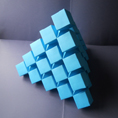 |
|
Name: Columbus Cubes
can be combined with separating pieces to produce
the Columbus Pyramid shown here. Modules / Paper
shape / Folding geometry: Each Columbus Cube is
made from 6 modules from squares using standard
folding geometry. Each joining piece is from a
square using standard folding geometry.
Designer /
Date: David Mitchell, 1997.
Diagrams:
In Building with Butterflies - David Mitchell -
Water Trade - ISBN 978-0-9534774-7-0.
|
|
| |
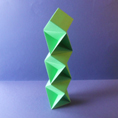 |
|
Name: The
Crooked Tower is made by combining Paul
Jackson Cubes and Robert Neale Octahedra
alternately in a stack Modules / Paper
shape / Folding geometry: Each Paul Jackson Cube
is made from 6 modules from squares using
standard folding geometry. Each Robert Neale
Octahedron is made from 6 modules from squares
using standard folding geometry.
Designer /
Date: David Mitchell, 1997.
Diagrams:
In Building with Butterflies - David Mitchell -
Water Trade - ISBN 978-0-9534774-7-0.
|
|
| |
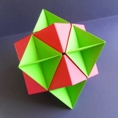 |
|
Name: The
Octacube is made by combining eight Paul
Jackson Cubes and six Robert Neale Octahedra.
Larger versions can be constructed by adding more
macromodules. Modules / Paper shape / Folding
geometry: Each Paul Jackson Cube is made from 6
modules from squares using standard folding
geometry. Each Robert Neale Octahedron is made
from 6 modules from squares using standard
folding geometry.
Designer /
Date: David Mitchell, 1997.
Diagrams:
Not yet available.
|
|
| |
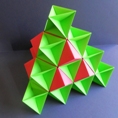 |
|
Name: Paul Jackson
Cubes and Robert Neale Octahedra can also be
combined to create a version of the Octahedral
Pyramid that I call the Octacube Pyramid. Modules / Paper
shape / Folding geometry: Each Paul Jackson Cube
is made from 6 modules from squares using
standard folding geometry. Each Robert Neale
Octahedron is made from 6 modules from squares
using standard folding geometry.
Designer /
Date: David Mitchell, 1997.
Diagrams:
Not yet available.
|
|
| |
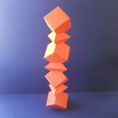 |
|
Name: The
Leaning Tower - a macromodular design
made by combining Paul Jackson Cubes and
Tricornes in a stack Modules / Paper
shape / Folding geometry: Each Paul Jackson Cube
is made from 6 modules from squares using
standard folding geometry. Each Tricorne is made
from 3 modules from squares using standard
folding geometry.
Designer /
Date: David Mitchell, 1998.
Diagrams: In Building with Butterflies - David
Mitchell - Water Trade - ISBN 978-0-9534774-7-0.
|
|
| |
 |
|
Name: Slide is
made by combining Columbus Cubes, Paul Jackson
Cubes and Tricornes in a pyramidal form. The
cubes and Tricorne's are linked together with
joining pieces. Modules / Paper shape / Folding
geometry: Each Paul Jackson Cube and each
Columbus Cube is made from 6 modules from squares
using standard folding geometry. Each Tricorne is
made from 3 modules from squares using standard
folding geometry.
Designer /
Date: David Mitchell, 2010.
Diagrams:
In Building with Butterflies - David Mitchell -
Water Trade - ISBN 978-0-9534774-7-0.
|
|
| |
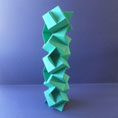 |
|
Name: The Icarus
Tower - a macromodular sculpture built
from Icarus Cubes using joining pieces. Modules / Paper
shape / Folding geometry: Each Icarus Cube is
made from 6 modules from squares using standard
folding geometry. Each joining piece is folded
from a one sixteenth size square using standard
folding geometry.
Designer /
Date: David Mitchell, 1998.
Diagrams: In Building with Butterflies - David
Mitchell - Water Trade - ISBN 978-0-9534774-7-0.
|
|
| |
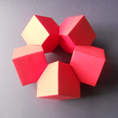 |
|
Name: The Ring
of Cubes can either be made by glueing
five Columbus Cubes together or by linking
together five Ring of Cubes macromodules, which
are provided with the necessary tabs and pockets
to make this possible without nedding to use
glue. Modules
/ Paper shape / Folding geometry: 30 modules from
squares using standard folding geometry.
Designer /
Date: David Mitchell, 1990 (both versions).
Diagrams
for the pure origami version can be found in
Building with Butterflies - David Mitchell -
Water Trade - ISBN 978-0-9534774-7-0.
|
|
| |
 |
|
Name: The Ring of
Cubes design can be extended, using either
method, to create a Ball of Cubes.
Further macromodules can be added to produce more
complex forms. Modules / Paper shape / Folding
geometry: 120 modules from squares using standard
folding geometry.
Designer /
Date: David Mitchell, 1990 (both versions).
Diagrams
for the pure origami version can be found in
Building with Butterflies - David Mitchell -
Water Trade - ISBN 978-0-9534774-7-0.
|
|
| |
| |



























